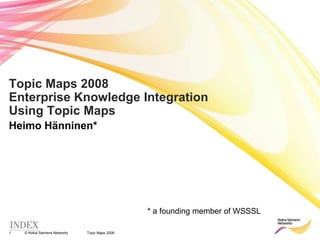Ontology driven portal based on ISO Topic Maps, 2008
- 1. Topic Maps 2008Topic Maps 2008Enterprise Knowledge Integration Using Topic Maps Heimo HĂ€nninen** a founding member of WSSSL
- 2. Heimo HĂ€nninen / Topic Maps 2008Goals (other than âgo try Topic MapsââŠ)Improved user experience (consistency)
- 3. One stop shopping for information
- 4. Better search based on harmonized metadata
- 6. Reusing business logic (service)
- 7. Simplifies application developmentHeimo HĂ€nninen / Topic Maps 2008Business viewpoint: Pain points in current portal(Portal supports users in operating and maintaining their telecom network)Users complain they cannot find the information they needSearch is poorUsers are used to more advanced functionalities on consumer portals and expect to have them in our portal as wellInflexibility of the architecture to provideDifferent views (dynamic views based on context)Linking capabilities â linking is mostly hard-codedPortal does not guide the users in any wayHigh development costs because of inflexible system architectureone-to-one integration modelno business logic reuse (redundancy)
- 8. Heimo HĂ€nninen / Topic Maps 2008Business goals 1/2Increased customer satisfaction and productivity through content discoveryNot only the users can find the information but they will discover information that they did not know ofEnhanced user experience: information is presented in a user-friendly way and information access methods are user-friendlySeamless user journeys from topic to topic, irregardless of âcontent domainâ and owning organizationCustomization: user sees only their products (but can also access full product portfolio if so wish)Personalization: user can indicate which products (and releases) they are working on and will see personalized views Filtering and sorting capabilities to drill down to desired informationGuiding the user to find the essential data rather than trying to provide all the possible dataIntelligent search (ontology-savvy search)
- 9. Heimo HĂ€nninen / Topic Maps 2008Business goals 2/2Process benefitsPeople who produce the contents for distribution do not have to be aware of all possible content that can be linked to their content â linking patterns can be automatedNavigation can be automatically populatedSystem benefitsData integration and mappingsFrom point-to-point integrations ï Data services
- 10. Heimo HĂ€nninen / Topic Maps 2008Knowledge Integration System evolutiona lot more months3 months18 monthsPoCâDynamoâPortal app.âPICâPortal Wide,Other applicationsJSPAppWeb AppsWeb AppsApp. XpresentationapplicationlogicRESTRESTas neededEnterprise Ontology & GlossaryServiceEnterprise ServiceKIlogicEAIEAImanualmessagesXML/ASCIImessagesXML/ASCIIdata sources
- 11. Heimo HĂ€nninen / Topic Maps 2008Cost savings by integration model and service approachpoint-to-pointmany-to-oneApp 1App 2App nApp 1App nApp 2biz logicintegrationintegration0.5*n kEurn kEurn kEur4*n kEurKI Servicebiz logic4*n kEuranyEAIintegrationintegrationEAIEAIEAIintegrationanalysis,integrationanalysis,integrationPDMCMSCMSCRMPDM
- 12. Heimo HĂ€nninen / Topic Maps 2008complete In-house: build application on top of RDBMSmid effort In-house: application & XML abstraction on RDBMS or XML-DBMSlower effort In-house: application on âKI savvy engine/ technologyâ ï way to goSelecting technology to build KI application12a2b3a3b3cService LayerKI Application(Java, PythonâŠ)KI AppKI AppKI AppKI Application(Java, PythonâŠ)KI Application(Java, PythonâŠ)APIAPIXML JDKAPITopic MapsEngineXML DB-engineRDFEngineXML APIXML APIOracle RDF-layer-DBCSQLSQLSQLXquerySQLSQLOracleSpatialXML-DBRDBMSRDBMSRDBMSRDBMS
- 13. Heimo HĂ€nninen / Topic Maps 2008Lessons learntTopic Maps are flexible yet easy to understand and modelPSI type of concept is mandatory in a large companyBack-end integrations are always more laborious than you thinkpolicies, security, data ownership, pipelines, mapping, data qualityâŠInvest in services, create interfaces as neededColliding interests â gap between EA and business:EA focuses on governance â top downInnovations are made in grassroots projects to fulfill biz needs â bottom upIterative mode of work, make mistakes early, find right peopleCreating a KI system takes two years â maturing process and changing mind set takes a decadeWorking ontology is a bottom-up effort, yet must keep in synch with corporate guidelinesDemand SW vendors to support âSubject-centric computingâ
- 14. Heimo HĂ€nninen / Topic Maps 2008Predicting future of semantic technology â Blue Ray or HD DVD dilemma ? Google âstudyâ - how unscientific is that? ïRDF vs. Topic Maps = 10:1RDF: google for "RDF softwareâ =10 800 hits1st: Welcome to RDF Software, home of the Structural Pest Control System for Windows ïTopic Maps: google for: "Topic Maps softwareâ = 938 hitsat Microsoft 20:1"RDF" site: microsoft.com = 1140 hits"Topic Maps" site:microsoft.com =59 hitsat IBM 22:1"RDF" site:ibm.com =5 350 hits"Topic Maps" site:ibm.com = 248 hitsat Oracle 450:1"RDF" site:oracle.com =3 600 hits"Topic Maps" site:oracle.com = 8 hits ⊠or perhaps some day a semantic gadget by
- 15. Heimo HĂ€nninen / Topic Maps 2008Ontology technology choicesLIFE IS HARD, BUT WE FEEL GOOD
- 16. Heimo HÀnninen / Topic Maps 2008⊠most likely both Topic Maps and RDF will have their place in the sunThank youand questions, please












